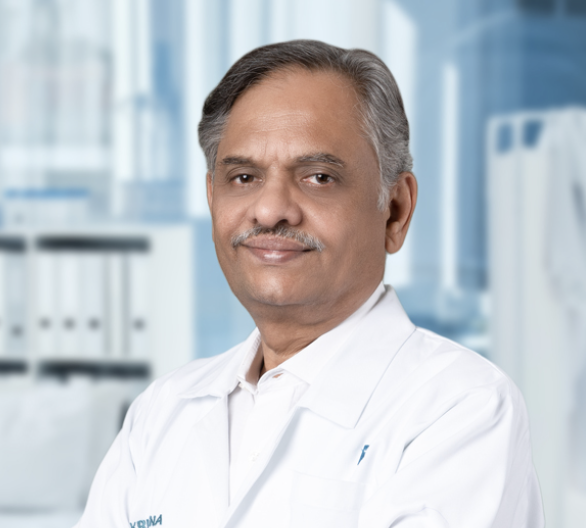Cyberknife Radiosurgery - Purpose, Side Effects & Success Rate

Treatment Duration
45 Minutes
------ To ------60 Minutes
Treatment Cost
₹ 3,00,000
------ To ------₹ 5,00,000

Table of Contents
Doctors use cyberknife radiosurgery to treat tumours in various body parts, such as the spine, lungs, liver, brain, neck, etc. This procedure involves using focused radiation beams to treat tumours without any incision. It uses stereotactic 3D imaging to target affected areas with minimal impact so that the surrounding healthy tissues are not harmed.
| Procedure Name | Cyberknife Radiosurgery |
| Alternative Name |
Stereotactic radiosurgery |
| Conditions Treated |
Brain Tumour, Tremors, Acoustic Neuroma, Arteriovenous Malformation (AVM) |
| Benefits of Surgery | Non-Invasive, Painless, Less recovery time, Surrounding tissue do not get affected |
| Treated By | Radiologist and Oncologist |
You can check Cyberknife Radiosurgery Cost here.
What is Cyberknife Radiosurgery?
Cyberknife radiosurgery might involve multiple sessions to treat the tumour completely. It damages the DNA of the targeted cells so that they are unable to reproduce, which leads to the shrinkage of the tumours. It is usually suggested when there is a tumour of the brain or spine involved because, in such cases, incisions can cause severe damage.
If cyberknife radiosurgery is used to treat any other body parts other than the brain, it is referred to as stereotactic body radiosurgery (SBRT).
Types of Technology Used in Cyberknife Radiosurgery
There are three types of technologies used to deliver the radiation needed for cyberknife radiosurgery for the brain and other parts of the body. They are:
- Gamma Knife: Gamma knife is a machine that uses around 200 beans of gamma rays to treat and target non-cancerous and cancerous tumours. They are not as common as the LINAC machines, but they are quite easily available and apt for small to medium tumours and lesions, especially in the brain.
- Linear Accelerator or LINAC: LINAC is helpful in performing radiosurgery on small tumours as it can shrink them only in a single session. However, large tumours might require multiple sessions. This process is also called fractionated cyberknife radiosurgery.
- Proton Beam Therapy: This is one of the most promising technologies for cyberknife radiosurgery because it can treat brain tumours in just one session, which makes the work a lot easier. Only a few research centres have this facility in the United States. However, in the past few years, the use of this technology has increased a lot because of the positive results it has delivered.
Expert Doctors (10)
NABH Accredited Hospitals (10)


Why is Cyberknife Radiosurgery Done?
Here are some of the conditions that can be treated with the help of cyberknife radiosurgery:
Brain Tumour
- It refers to the growth of abnormal cells in the brain. These cells form a mass. The tumour (mass) can be cancerous or non-cancerous.
- The cyberknife surgery targets these brain tumours by emitting a narrow beam of radiation from a robotic arm. This arm moves around the affected site and targets the tumour. These target sites are marked by the doctor before the surgery so that the robotic arm can automatically track them.
Tremors
- Tremors refer to the rhythmic shaking of one or more body parts. These occur because of muscle contractions in the affected body part. Tremors are more commonly experienced in hands, but they can also affect legs, trunks, vocal cords, etc.
- A Gamma knife is used to treat tremors. Multiple radiation beams are targeted to the affected site to treat the muscle contraction.
Acoustic Neuroma
- Acoustic neuroma refers to the development of a non-cancerous tumour (benign) on the main nerve that leads from the inner ear to the brain.
- Cyberknife radiosurgery delivers small doses of radiation to the targeted tumours that break them into smaller pieces. This ensures that the tumours do not subdivide and ultimately stop growing. With a few sessions, the tumours shrink and get eliminated.
Arteriovenous Malformation (AVM)
- AVM refers to an abnormal tangling of blood vessels that connect the arteries and veins in the brain or spine.
- Cyberknife radiosurgery targets the radiation beams to the tangled blood vessels. These beams damage the walls of the blood vessels, which frees the arteries and veins. After the procedure, the vessels gradually degenerate in a few months.
Pituitary Tumours
- This tumour forms in the pituitary gland found in the skull. A large pituitary tumour can damage the surrounding nerves by pressing upon them. It can also disturb various hormonal levels in the body.
- Radiosurgery uses imaging guidance techniques to deliver high doses of radiation beams to the pituitary tumours. This eliminates the tumours in a few sessions and avoids damage to healthy cells.
Trigeminal Neuralgia
- Trigeminal neuralgia refers to painful sensations on one side of the face. These sensations feel similar to an electric shock. They may be caused due to the pressure imposed by a cyst or tumour on the nerve found at the base of the head. This nerve joins the brain stem to the spinal cord.
- The Cyberknife system delivers high doses of radiation beams to destroy the pain fibres in the affected nerve.
How is Cyberknife Radiosurgery peformed?
- In cyberknife radiosurgery, static radio waves are created with the small beams for radiation, and they are passed through the body part that contains the tumour. The surrounding healthy tissues are not affected by the radio waves.
- A targeted dose of beams is sent to the part that has the tumours. If the tumour is big, it shrinks over time by being broken into small parts or abnormalities with the help of the beams.
- Due to the beams, the blood vessels also close. This ensures that the tumour loses its blood supply.
What Makes Cyberknife Radiosurgery Unique?
- Real-time motion synchronization makes Cyberknife radiosurgery unique and better than other forms of radiation therapies.
- This means that movements inside the patient’s body due to breathing, shifting of gas in the bowel, or filling of the bladder may cause the tumour to move as well.
- Even if the tumour moves by a centimetre, it can become challenging for the doctor to target them. However, motion synchronization allows the doctor to deliver the radiation even if the tumour moves.
- Cyberknife radiosurgery is the only treatment that accommodates motion management of the patient and the tumour even while the radiations are being delivered.
- During this procedure, the patient is allowed to move slightly and change their position. This makes the patient feel more relaxed during the treatment.
What is the Success Rate of Cyberknife Radiosurgery for Tumours & Lesions?
- Cyberknife as a primary treatment option, can help achieve a local control in around 90% of patients with 18 months of median follow-up. 25%-85% of people got relief from radicular pain.
What to expect before and on the day of the surgery?
Before the Cyberknife Radiosurgery
- A head frame is attached to the patient so that the targeted points for the beams can be analyzed. This frame has multiple pins that are placed on the head depending on the placement of the tumours. They are also helpful in stabilizing the head during radiation surgery.
- Regular scans are done to confirm the placement of the tumours. Multiple scans for imaging are required by the doctor before the patient undergoes surgery to check the location of the abnormalities in the head. The same goes for any other part of the body.
The scans that the doctor takes depend on the affected body part, such as:
- MRI scans or CT scans of blood vessels that need to be blocked.
- X-rays for proper imaging and detailed analysis of the affected site, especially the brain.
- Lastly, dose planning of the radiation to be passed through the head or body is done based on the severity or the size of the tumours.
- The body or head will also be marked at the affected places to ensure that the right target points are identifiable for treatment.
During the Cyberknife Radiosurgery
- Children are given anaesthesia to ensure that they are calm and relaxed during the whole process. Adults are given a sedative instead of anaesthesia.
- The sessions are performed on an outpatient basis. This means that the person will not be hospitalized before the session. They only have to visit the hospital on the day of the treatment.
- The average duration of each session is 30 to 90 minutes.
- An important thing to remember is that the person won’t feel the radiation passing through their body. The imaging and the scans will help the doctor send beams to the affected sites. During the procedure, the person can also talk to the doctor via a microphone in case it is required.
What can you expect after the surgery?
After the Cyberknife Radiosurgery
- The head frame is removed.
- The patient can start eating and drinking after a few hours.
- They may need to rest for at least a week.
- People may also need to take off from their work to avoid exertion.
- Rigorous physical activity should not be performed by the patient.
Results of Cyberknife Radiosurgery
- The tumour might not instantly shrink and get eliminated. In some cases, it takes a few months and even a couple of years for the tumour to completely vanish. However, it is certain that the same tumours will not grow after the treatment because their blood supply is stopped.
- The patient might still feel pain at the affected site, which might take a few weeks to completely go away.
Self-Care After the Cyberknife Radiosurgery
- It is recommended to have someone take care of the patient after the procedure and help them perform physical, day-to-day activities, such as walking, bending, etc.
- The doctor might also give some medications for the pain, which will provide temporary relief.
Benefits of Cyberknife Radiosurgery
Benefits of Cyberknife Radiosurgery include:
- It is a non-invasive procedure.
- The treatment is painless.
- It is performed on an outpatient basis, so there is no need to get admitted to the hospital.
- The recovery time is quite less.
- This procedure can treat various kinds of tumours, both cancerous and non-cancerous.
- The surrounding tissues do not get affected during this procedure.
Risks and Complications Associated with Cyberknife Radiosurgery
Here are some complications that might arise:
- After every session, the patient may feel tired. He/she requires ample rest to wave off the tiredness.
- The patient may find swelling at the affected site. If they have had a brain tumour removed, they may also experience nausea, dizziness, light-headedness, vomiting, headache, etc.
- There may be redness, swelling, pain, inflammation, irritation, etc., on the scalp.
Last Updated on: 13 November 2022
Author
HexaHealth Care Team
HexaHealth Care Team brings you medical content covering many important conditions, procedures falling under different medical specialities. The content published is thoroughly reviewed by our panel of qualified doctors for its accuracy and relevance.






















